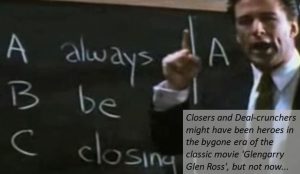
Image:Alec Baldwin in Glengarry Glen Ross (1992)
I have been reminded over recent weeks how important it is not to “sell” during B2B sales discussions. Three colleagues have separately shared stories with me where someone on their team have jumped in too early with pricing discussions or what sounds like negotiations, or labouring over the features before understanding what the customer values.
So here are my Top Four Tips for B2B ‘sales” (or rather, customer engagement):
1. B2B sales is a process – must be matched to how your customer buys.
Each business will purchase differently, you need to know how the business you are engaging with buys. This is one of the first things to find out as your are starting discussions.
The process for B2B sales is typically four main stages: 1: Getting to know each other; 2: Understanding goals, needs and problems; 3: Demonstrate Capability; 4: Obtaining Commitment (thanks Neil Rackham). Stage 1 should be fairly swift, remember people (even businesses) buy from people they know, like and trust – you don’t need to be their best friend, just someone they can like and trust. Understanding what the customer is trying to achieve is critical. Know their goals. Demonstrating your capability to meet those goals has to honestly recognise the risk for the customer and suggestions from you to reduce the risk of not realising the goals. If you can demonstrate capability that matches they goals and risk profile, then you move into Stage 4, how you are going to work together, the process of procurement.
Work though each stage with the customer, one at a time. You must not jump from one stage to another, be patient and work through the process at the customer’s pace.
2. The objective of ‘selling’ is to open a relationship, not ‘close a deal’.
Closers and Deal-crunchers might have been heroes in the bygone era of the classic movie ‘Glengarry Glen Ross’, but not now.
Over the last 15-20 years how we buy has completely changed and sales leaders are yet to catch up.
Whether it is B2C or B2B, the change is in the buyer; buyers are more resistant to sales practices than before, they have more information available to them than ever before and their ‘voice’/word-of-mouth has never had more reach than it does now. So, today, the goal of Sales is to open a relationship with a person who will become a profitable promoter of what you do. Therefore our behaviours and actions need to reflect our goal and the old sales tricks are out.
3. Never tell the price until you have explained the value.
Okay, maybe a ‘ballpark’ figure early on. But the price in the early stages has very little context. If I want to buy a new lap top, is it $5000, or $500 – the price is irrelevant unless the context of what I want to use the lap top for is known.
If a business wants to put in a CRM system, the price of the software licenses or even any hardware needed is irrelevant until the context of the business results are understood from having a CRM system. And then the context of the expected business results need to be balanced with the risk (to the business) in realising the benefits. Only then can the costs be put into a context that provides the buyers need to make informed decisions.
To meaningfully explain value you must understand the problems to be solved and the value your solution represents to your specific customer.
4. People do not care about what you do, or can do. They only care about what you can do for them.
People make up the business buying groups. They will often have different agendas, perspectives or needs. Salespeople have a propensity to talk a lot about what they can do, or what they have done before for others. This attention to features is somewhat like scattering seed in the wind, throwing lots of product advantages out there hoping some of them take root with the buyers.
Stop talking at length about the features of your product or solution. Make everything relevant to the people you are engaging with.
Follow these four tips and you will be much closer to engaging on a human level with your potential customers. Rather than sounding like someone that is trying to coerce them into a decision, or push them along at the wrong pace – either way this behaviours disengage people from what you have to say.



